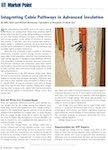As society shifts toward environmentally responsible architecture the promise of energy savings, optimized water management, and improved environmental quality become significant in both meaning and implementation. Traditional legal precedents may no longer apply or may fail to recognize the nuances of this important emerging market. Change, in the legal sense, may lead to unforeseen confusion.
I’ve asked a friend and noted construction law attorney, Christopher Hill, to provide a layperson's perspective on the matter. Chris is nationally respected in legal circles and adds value as a Leadership in Energy and Environmental Design Accredited Professional. For those unfamiliar with the LEED AP designation, accreditation requires deep understanding of sustainable design as defined by the US Green Building Council (USGBC). Chris is serious about sustainability and assumes leadership with the emergence of “green” in law. He’s also an entertaining writer. Please enjoy the post:
I am a great believer in sustainable building and the benefits (both economic and environmental) that will come with a more universal adoption of sustainable, more resource friendly, building practices. However, and as I’ve said at Musings before, Eeyore is one of my favorite characters from A.A. Milne. Eeyore, you may remember, is the donkey on whom it’s always raining. He is the loveable character that always feels like the sky is falling, but plugs along anyway.
I can relate. I think that the economic impact, combined with the moral imperative, make such a goal both worthy and required. However, certain risks are inherent in any new use of technologies and any new mode of thinking, no matter how worthy. Some of the issues that will need to be dealt with by contractors, architects, owners and, yes, lawyers, are the following:
- Insurance- the insurance industry is still catching up with energy related underwriting
- What standard of care applies to a green building claim?
- Potential Trademark claims
- Longer time horizons and contractual or government requirements on energy goals
- Even the possibility of a broken window.
- Zoning
The sooner the risks are at least out in the open, if not resolved, the sooner the private sector will get fully behind sustainable construction and building management. Awareness of the issues is more than half the battle. From this awareness will come solutions. I fully believe that these solutions will lead to a better built environment and to contractors and subcontractors that no longer find sustainability to be a novelty, but the normal practice.
My hope is that by pulling back on the reins a bit and hopefully forcing a discussion of these issues, I (and my alter ego that down in the dumps donkey) will help lead to a more robust, and less legally risky, building landscape.
Until then, Eeyore and I will keep plugging through the rain.
Christopher Hill is a LEED AP and construction lawyer in Richmond, VA. He is a member of Virginia’s Legal Elite in Construction Law and authors the Construction Law Musings blog. You can also follow him on Twitter at @constructionlaw.







.jpg)


Great post. Mr. Lee raises some very excellent points.
ReplyDelete